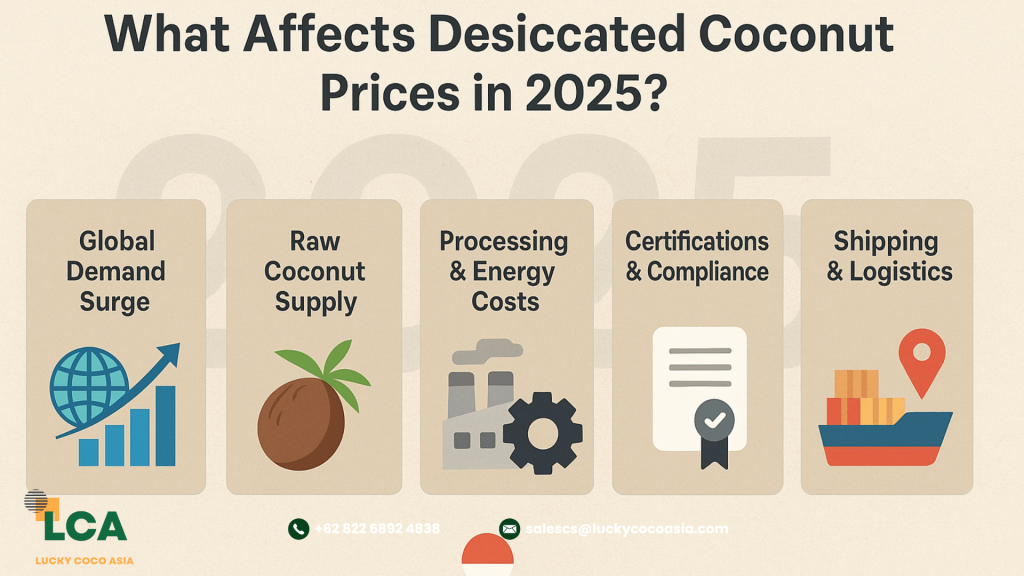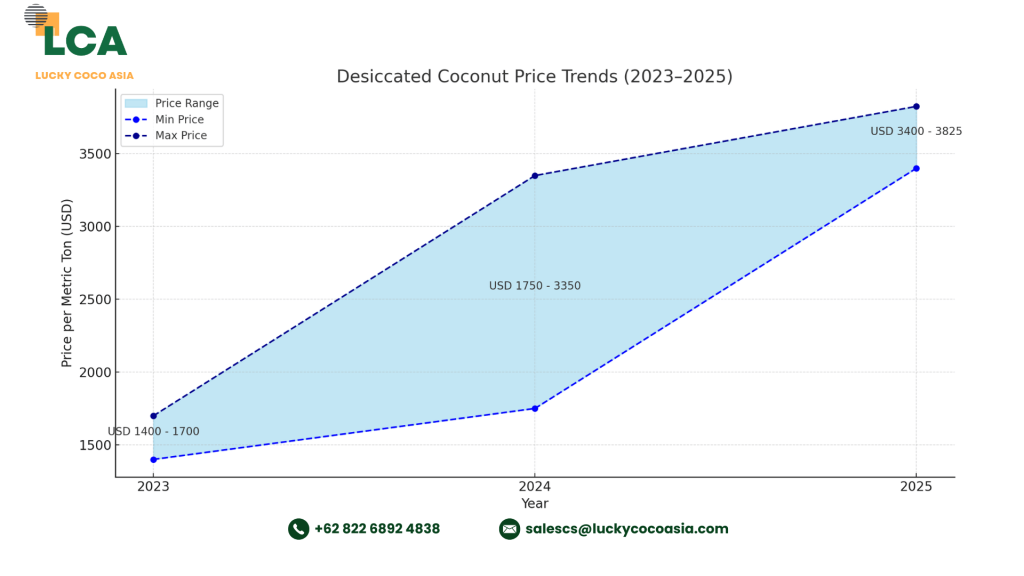Desiccated Coconut Price Trends 2025

Desiccated Coconut Price Trends 2025: What Affects Cost?
Desiccated Coconut Price Trends 2025 – As 2025 unfolds, the desiccated coconut industry continues to evolve. Prices are no longer just influenced by supply and demand. From global trade dynamics to sustainability initiatives and energy costs, various factors are shaping how much buyers pay per metric ton. For food manufacturers, importers, and traders, understanding these variables is key to making better sourcing decisions.
In this article, we break down the top drivers affecting desiccated coconut prices in 2025, based on market insights and sourcing trends.
1. Global Demand Growth and Market Realignment in Desiccated Coconut Price Trends 2025
The global appetite for coconut-based ingredients is stronger than ever. Desiccated coconut is now widely used not only in bakery, confectionery, and snack foods, but also in health-focused product categories like keto, gluten-free, and vegan diets. (Read also: Desiccated Coconut for Food Manufacturing)
China, for instance, ramped up its imports in early 2025, purchasing over 68,000 metric tons worth USD 29.5 million from Indonesia alone (Source). This surge reflects broader consumer trends and increased use of coconut in mainstream and niche food formulations.
As countries like Germany, the UK, and the Netherlands also expand their import volumes, prices naturally respond to the upward pull of demand.

2. Raw Coconut Availability and Seasonal Volatility – Desiccated Coconut Price Trends 2025
While demand rises, the raw coconut supply remains sensitive to climate patterns, harvest cycles, and local farming conditions. Indonesia, a top exporter of desiccated coconut, has regions like North Sulawesi and Halmahera that produce year-round—but they still face weather disruptions.
For instance, El Niño patterns in late 2024 led to drier conditions in some coconut-producing zones, reducing yields and tightening supply in early Q1 2025.
Farm gate prices for mature coconuts—measured in IDR per nut—have increased by 10–15% compared to last year. These raw material hikes ripple down to processing plants and eventually to the final product price.
3. Energy and Processing Costs – Desiccated Coconut Price Trends 2025
Desiccated coconut manufacturing is energy-intensive. From drying to metal detection, it involves strict controls and high electricity usage. For factories still reliant on fossil fuels or unstable grid electricity, the cost of production increases significantly. (Read also: Green Energy Coconut Biomass for Carbon Reduction)
At Lucky Coco Asia, we’ve tackled this by implementing biomass energy using coconut husk by-products. This approach helps stabilize operating costs and reduce carbon footprint. However, many other suppliers have seen their production costs rise, especially with diesel and gas price fluctuations.
4. Certifications and Compliance Costs
Importers, especially in the EU and USA, demand coconut products that meet strict food safety and traceability standards.
These include:
-
FSSC 22000 (Food Safety)
-
USDA Organic & EU Organic
-
Kosher & Halal Certification
While these certifications are vital for accessing premium markets, they add operational costs—ranging from documentation systems to routine audits. Certified desiccated coconut may cost slightly more but is often rewarded with long-term contracts and customer trust.
5. Shipping and Export Logistics
Freight rates have somewhat stabilized post-pandemic, but port congestion, container shortages, and regional conflicts (like those affecting the Suez Canal or Red Sea trade routes) still cause occasional spikes in shipping costs.
Buyers choosing CIF (Cost, Insurance, and Freight) pricing should keep an eye on these variables. On the other hand, FOB (Free on Board) options may give them more control over logistics but shift the burden of freight risk.
6. Currency Fluctuations and Payment Terms
Most global coconut trade is conducted in USD, while the costs in producer countries like Indonesia are in IDR (Indonesian Rupiah). Any currency mismatch between these two can influence pricing.
When the Rupiah weakens against the Dollar, exporters may reduce USD pricing slightly. But when the local currency strengthens, exporters must adjust prices upward to cover raw material and labor expenses.
Final Thoughts: What Can Buyers Do?
To navigate the pricing landscape in 2025, here are three smart strategies for desiccated coconut buyers:
-
Build relationships with transparent suppliers – like Lucky Coco Asia, who openly communicate cost drivers.
-
Opt for certified products – ensuring compliance and reducing risk of rejection at customs.
-
Diversify contracts – combine long-term agreements with flexible spot orders to manage cost variability.
Conclusion
Desiccated coconut prices in 2025 reflect a complex mix of market forces, from raw material availability and certification requirements to shipping costs and sustainability efforts. By understanding these variables, buyers can make smarter purchasing decisions—and build partnerships that go beyond the price per ton. (Contact us here)

